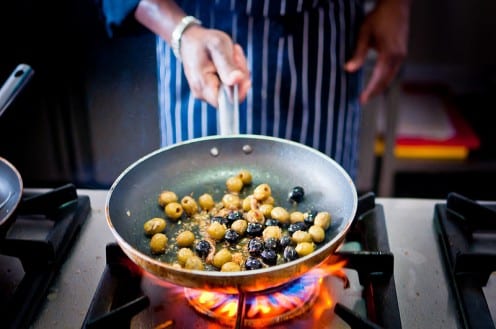
Image courtesy of Chris Zielecki, Creative Commons
Well into the thick of looking at what people post, there are the obvious recurrences of photos of family, friends, selfies or being seen somewhere, like a club, event or on holiday. There is also another genre that I think begins with photos of food. There are lots of posts of food at restaurants, but there are also lots of photos of self-prepared food. In Trinidad, there is definitely a sense of photos being posted because they are a ‘Trini’ dish, but what of cakes and cupcake decorating for example, that aren’t particularly Trini? Especially being the last week of the year and Christmas week, there are more photos of ‘things I have made’ than usual. The ‘things I have made’ genre also extends to parties, weddings and baby showers- social gatherings, where trinkets on tables, flower arrangements, gifts for guests are also the products of assemblage by individuals and not commercially bought as finished products (which, I suppose would be ‘things I have bought’.)
We have started asking informants what they think of things posted by others. Sandra, an admin assistant in her late twenties, mostly posts photos of things she has cooked or baked. Another informant looked at images only of her posts and described her dishes as cosmopolitan and therefore, Sandra must be or aspires to be a cosmopolitan person. One of Sandra’s friends posted origami Christmas decorations to her wall with paper that Sandra had bought her for her birthday. Another friend volunteers to make party trinkets and decorations for their friends and posts them on her own timeline, so following the chain of associations by following one friend’s post to another friend’s timeline, we can start to assume that this is a crafty bunch of friends that have a shared interest in DIY.
Razvan and Danny discussed some time ago what Facebook might mean for commercial photography and for professions such as the wedding photographer. With camera phones and quick filter apps such as Instagram, any photo can look good and is instantly available at no cost. Instagram is not big in my fieldsite in Trinidad, but photography for the social pages of newspapers and Facebook are. Photographers go to fetes, events and parties, photograph people and post them, so individuals don’t have to pay anyone for professional photos to be taken. Some of these photographers are amateurs themselves who build their profile by branding images and posting them on Facebook.
The two weddings I was invited to during my last period of fieldwork also had invitations made, not from a commercial design firm, but through a Photoshop savvy relative who simply printed the invitations at the local office shop (and one of the couples posted photos of the invitation on Facebook). Printed Christmas cards are also a long standing tradition in Trinidad, and this week, I have seen a flood of posts of Christmas images and photos of people modified by an editing app that surrounds the image with Christmas-themed borders and decorations.
Of course, like any observation, I would need to systematically investigate the genre of DIY and ‘things I have made’ further, and its relevance to social media. The town of El Mirador is still a place where brands and the amount spent on commercial goods are indicators of status, but there are also conversations around ethical consumption, waste, and environmentalism that are resulting in a small DIY subculture. It also a town where DIY has been valued for at least two generations, with the building and modification of homes; painting, renovation, and adding extensions (where men and their relatives do this rather than hiring work men). The key difference is that for the previous generation, such forms of DIY weren’t able to be shared and catalogued through a platform like Facebook. Homes had to be visited in order to be appreciated. But now, I don’t have to eat one of Sandra’s magnificent cupcakes to appreciate the time, creativity and labour she has put into it.
Filed under Anthropology, Culture, Trinidad
Tags: Christmas, cooking, craft, cupcakes, DIY, Facebook, food, Instagram, photography
1 Comment »
 Close
Close






